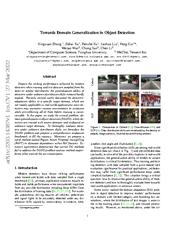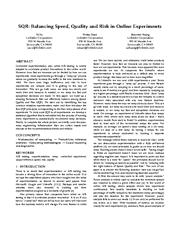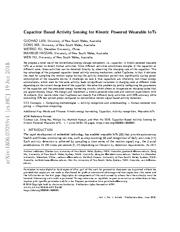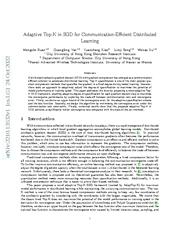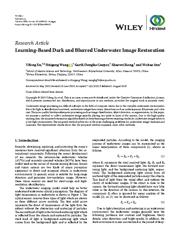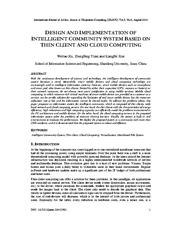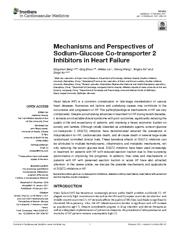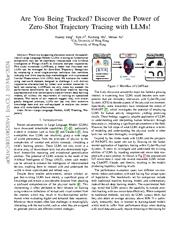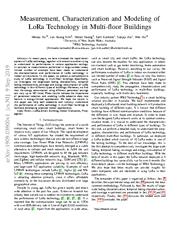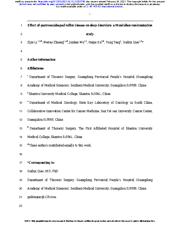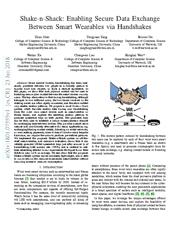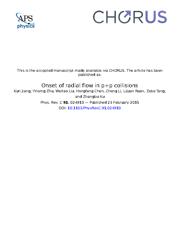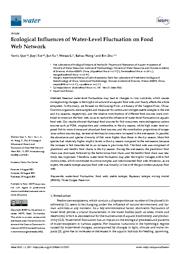A copy of this work was available on the public web and has been preserved in the Wayback Machine. The capture dates from 2022; you can also visit the original URL.
The file type is application/pdf.
Filters
Towards Domain Generalization in Object Detection
[article]
2022
arXiv
pre-print
Despite the striking performance achieved by modern detectors when training and test data are sampled from the same or similar distribution, the generalization ability of detectors under unknown distribution shifts remains hardly studied. Recently several works discussed the detectors' adaptation ability to a specific target domain which are not readily applicable in real-world applications since detectors may encounter various environments or situations while pre-collecting all of them before
arXiv:2203.14387v1
fatcat:esq7xq4kurczhjkt4fjegbxf7y
more »
... raining is inconceivable. In this paper, we study the critical problem, domain generalization in object detection (DGOD), where detectors are trained with source domains and evaluated on unknown target domains. To thoroughly evaluate detectors under unknown distribution shifts, we formulate the DGOD problem and propose a comprehensive evaluation benchmark to fill the vacancy. Moreover, we propose a novel method named Region Aware Proposal reweighTing (RAPT) to eliminate dependence within RoI features. Extensive experiments demonstrate that current DG methods fail to address the DGOD problem and our method outperforms other state-of-the-art counterparts.
SQR: Balancing Speed, Quality and Risk in Online Experiments
[article]
2018
arXiv
pre-print
Controlled experimentation, also called A/B testing, is widely adopted to accelerate product innovations in the online world. However, how fast we innovate can be limited by how we run experiments. Most experiments go through a "ramp up" process where we gradually increase the traffic to the new treatment to 100%. We have seen huge inefficiency and risk in how experiments are ramped, and it is getting in the way of innovation. This can go both ways: we ramp too slowly and much time and resource
arXiv:1801.08532v1
fatcat:2gsigz3vvfchvmaaendbtayerm
more »
... is wasted; or we ramp too fast and suboptimal decisions are made. In this paper, we build up a ramping framework that can effectively balance among Speed, Quality and Risk (SQR). We start out by identifying the top common mistakes experimenters make, and then introduce the four SQR principles corresponding to the four ramp phases of an experiment. To truly scale SQR to all experiments, we develop a statistical algorithm that is embedded into the process of running every experiment to automatically recommend ramp decisions. Finally, to complete the whole picture, we briefly cover the auto-ramp engineering infrastructure that can collect inputs and execute on the recommendations timely and reliably.
Capacitor Based Activity Sensing for Kinetic Powered Wearable IoTs
[article]
2018
arXiv
pre-print
More recently, Xu et al. [46] proposed an authentication system which utilizes the AC voltage signal to authenticate the user based on gait analysis. ...
arXiv:1806.07055v1
fatcat:6rdppdttlzgtpmpck5fva477cu
Simultaneous Energy Harvesting and Gait Recognition using Piezoelectric Energy Harvester
[article]
2020
arXiv
pre-print
A recent attempt by Xu et al. ...
Although the feasibility of using PEH for human gait recognition has been demonstrated by Xu et al. [11] , our work differs in two aspects. ...
arXiv:2009.02752v1
fatcat:c4naarh5yngydjwht4mwmqyntu
Adaptive Top-K in SGD for Communication-Efficient Distributed Learning
[article]
2022
arXiv
pre-print
Distributed stochastic gradient descent (SGD) with gradient compression has emerged as a communication-efficient solution to accelerate distributed learning. Top-K sparsification is one of the most popular gradient compression methods that sparsifies the gradient in a fixed degree during model training. However, there lacks an approach to adaptively adjust the degree of sparsification to maximize the potential of model performance or training speed. This paper addresses this issue by proposing
arXiv:2210.13532v1
fatcat:onzck4ae2rg63ktxlcba2nrxre
more »
... novel adaptive Top-K SGD framework, enabling adaptive degree of sparsification for each gradient descent step to maximize the convergence performance by exploring the trade-off between communication cost and convergence error. Firstly, we derive an upper bound of the convergence error for the adaptive sparsification scheme and the loss function. Secondly, we design the algorithm by minimizing the convergence error under the communication cost constraints. Finally, numerical results show that the proposed adaptive Top-K in SGD achieves a significantly better convergence rate compared with the state-of-the-art methods.
Learning-Based Dark and Blurred Underwater Image Restoration
2020
Complexity
out data curation; and Weitao Sun carried out software. ...
Huigang Wang carried out project administration; Yifeng Xu carried out conceptualization and methodology, investigation, and writing; Garth Douglas Cooper carried out review and editing; Shaowei Rong carried ...
doi:10.1155/2020/6549410
fatcat:ba4hnt2n2betviaxbeswjslrm4
Design and Implementation of Intelligent Community System Based on Thin Client and Cloud Computing
[article]
2014
arXiv
pre-print
Xu received his Bachelor's degree in Communication Engineering in 2006, and his Master's degree in Information System in 2010, from Shandong University. ...
Above 80%
<=20%(common
users)
<=50%(common
users)
Virtualization
The resource usage
rate is low
The resource usage
rate is low
Others
Be suitable for work,
recreation and education
Weitao ...
arXiv:1409.3092v1
fatcat:femwwextqbdv3jfxxessegoqei
Mechanisms and Perspectives of Sodium-Glucose Co-transporter 2 Inhibitors in Heart Failure
2021
Frontiers in Cardiovascular Medicine
Heart failure (HF) is a common complication or late-stage manifestation of various heart diseases. Numerous risk factors and underlying causes may contribute to the occurrence and progression of HF. The pathophysiological mechanisms of HF are very complicated. Despite accumulating advances in treatment for HF during recent decades, it remains an intractable clinical syndrome with poor outcomes, significantly reducing the quality of life and expectancy of patients, and imposing a heavy economic
doi:10.3389/fcvm.2021.636152
pmid:33644138
pmcid:PMC7902509
fatcat:wghwulhuljhuxkoxwpjyjf3vqe
more »
... urden on society and families. Although initially classified as antidiabetic agents, sodium-glucose co-transporter 2 (SGLT2) inhibitors have demonstrated reduced the prevalence of hospitalization for HF, cardiovascular death, and all-cause death in several large-scale randomized controlled clinical trials. These beneficial effects of SGLT-2 inhibitors can be attributed to multiple hemodynamic, inflammatory and metabolic mechanisms, not only reducing the serum glucose level. SGLT2 inhibitors have been used increasingly in treatment for patients with HF with reduced ejection fraction due to their surprising performance in improving the prognosis. In addition, their roles and mechanisms in patients with HF with preserved ejection fraction or acute HF have also attracted attention. In this review article, we discuss the possible mechanisms and applications of SGLT2 inhibitors in HF.
Are You Being Tracked? Discover the Power of Zero-Shot Trajectory Tracing with LLMs!
[article]
2024
arXiv
pre-print
There is a burgeoning discussion around the capabilities of Large Language Models (LLMs) in acting as fundamental components that can be seamlessly incorporated into Artificial Intelligence of Things (AIoT) to interpret complex trajectories. This study introduces LLMTrack, a model that illustrates how LLMs can be leveraged for Zero-Shot Trajectory Recognition by employing a novel single-prompt technique that combines role-play and think step-by-step methodologies with unprocessed Inertial
arXiv:2403.06201v1
fatcat:gogvbdwwifhwveptl64uohzfcu
more »
... ement Unit (IMU) data. We evaluate the model using real-world datasets designed to challenge it with distinct trajectories characterized by indoor and outdoor scenarios. In both test scenarios, LLMTrack not only meets but exceeds the performance benchmarks set by traditional machine learning approaches and even contemporary state-of-the-art deep learning models, all without the requirement of training on specialized datasets. The results of our research suggest that, with strategically designed prompts, LLMs can tap into their extensive knowledge base and are well-equipped to analyze raw sensor data with remarkable effectiveness.
Measurement, Characterization and Modeling of LoRa Technology in Multi-floor Buildings
[article]
2019
arXiv
pre-print
In recent years, we have witnessed the rapid development of LoRa technology, together with extensive studies trying to understand its performance in various application settings. In contrast to measurements performed in large outdoor areas, limited number of attempts have been made to understand the characterization and performance of LoRa technology in indoor environments. In this paper, we present a comprehensive study of LoRa technology in multi-floor buildings. Specifically, we investigate
arXiv:1909.03900v1
fatcat:n65n74spy5ah5bqwflzriqdgdy
more »
... he large-scale fading characteristic, temporal fading characteristic, coverage and energy consumption of LoRa technology in four different types of buildings. Moreover, we find that the energy consumption using different parameter settings can vary up to 145 times. These results indicate the importance of parameter selection and enabling LoRa adaptive data rate feature in energy-limited applications. We hope the results in this paper can help both academia and industry understand the performance of LoRa technology in multi-floor buildings to facilitate developing practical indoor applications.
Effect of gastroesophageal reflux disease on sleep disorders: a Mendelian randomization study
[article]
2023
medRxiv
pre-print
Research project organization and execution: Weitao Zhuang and Yong Tang. Data curation: Zijie Li, Junhan Wu, and Haijie Xu. ...
doi:10.1101/2023.02.11.23285798
fatcat:zvlo2c3uivedfc55dfrxdysr7e
Shake-n-Shack: Enabling Secure Data Exchange Between Smart Wearables via Handshakes
[article]
2018
arXiv
pre-print
Since ancient Greece, handshaking has been commonly practiced between two people as a friendly gesture to express trust and respect, or form a mutual agreement. In this paper, we show that such physical contact can be used to bootstrap secure cyber contact between the smart devices worn by users. The key observation is that during handshaking, although belonged to two different users, the two hands involved in the shaking events are often rigidly connected, and therefore exhibit very similar
arXiv:1801.07555v1
fatcat:c4stbemmcbaanbt6226tsk7wzq
more »
... ion patterns. We propose a novel Shake-n-Shack system, which harvests motion data during user handshaking from the wrist worn smart devices such as smartwatches or fitness bands, and exploits the matching motion patterns to generate symmetric keys on both parties. The generated keys can be then used to establish a secure communication channel for exchanging data between devices. This provides a much more natural and user-friendly alternative for many applications, e.g. exchanging/sharing contact details, friending on social networks, or even making payments, since it doesn't involve extra bespoke hardware, nor require the users to perform pre-defined gestures. We implement the proposed Shake-n-Shack system on off-the-shelf smartwatches, and extensive evaluation shows that it can reliably generate 128-bit symmetric keys just after around 1s of handshaking (with success rate >99%), and is resilient to real-time mimicking attacks: in our experiments the Equal Error Rate (EER) is only 1.6% on average. We also show that the proposed Shake-n-Shack system can be extremely lightweight, and is able to run in-situ on the resource-constrained smartwatches without incurring excessive resource consumption.
Expression of centrosomal protein 55 in glioma tissue and the influence on glioma cell functions
2019
Translational Cancer Research
Centrosomal protein 55 (CEP55) protein has high expression levels in various tumors and plays important regulatory effects on cell cycle. We aimed to detect the expressions of CEP55 in glioma tissues, and to evaluate the effects on glioma cell functions and apoptosis. Fifty fresh astrocytoma tissue samples resected from surgeries were collected, and twenty normal brain tissue samples were obtained as a control group. CEP55 protein expressions were measured by Western blot and
doi:10.21037/tcr.2019.01.33
pmid:35116751
pmcid:PMC8799232
fatcat:udnthyu3dvfellzmy2pqkp7ina
more »
... assay. After siRNA interference, the proliferation, migration, invasion and apoptosis of glioma cell lines LN229/T98G were detected by MTT assay, scratch assay, Transwell assay and flow cytometry respectively. The expression level of CEP55 protein in glioma tissue was significantly higher than that in normal control group, and the expressions in glioma tissues were elevated with increasing grade. Glioma cell lines in which CEP55 expression was stably knocked down were successfully constructed. MTT assay showed that the growth of these cells was significantly slowed down compared with that of normal cells. Scratch assay exhibited that their migration capability significantly decreased. Transwell assay revealed that the invasive ability was also attenuated with decreasing CEP55 expression. Flow cytometry showed that down-regulated expression of CEP55 promoted the apoptosis of LN229/T98G cells. CEP55 expression increased in glioma tissues. After interference of its expression, glioma cell functions were significantly weakened, and apoptosis was facilitated. CEP55 may be a molecular marker for glioma diagnosis or a new target for molecular therapy.
Onset of radial flow inp+pcollisions
2015
Physical Review C
It has been debated for decades whether hadrons emerging from p+p collisions exhibit collective expansion. The signal of the collective motion in p+p collisions is not as clear/clean as in heavy-ion collisions because of the low multiplicity and large fluctuation in p+p collisions. Tsallis Blast-Wave (TBW) model is a thermodynamic approach, introduced to handle the overwhelming correlation and fluctuation in the hadronic processes. We have systematically studied the identified particle spectra
doi:10.1103/physrevc.91.024910
fatcat:fw6vsqb4znfbjmv4ygnmpwnsra
more »
... n p+p collisions from RHIC to LHC using TBW and found no appreciable radial flow in p+p collisions below √ s = 900 GeV. At LHC higher energy of 7 TeV in p+p collisions, the radial flow velocity achieves an average value of β = 0.320 ± 0.005. This flow velocity is comparable to that in peripheral (40-60%) Au+Au collisions at RHIC. Breaking of the identified particle spectra mT scaling was also observed at LHC from a model independent test.
Ecological Influences of Water-Level Fluctuation on Food Web Network
2021
Water
Seasonal water-level fluctuations may lead to changes in river nutrients, which causes corresponding changes in the trophic structure of an aquatic food web, and finally affects the whole ecosystem. In this study, we focused on the Ganjing River, a tributary of the Yangtze River, China. Common organisms were sampled and measured for carbon and nitrogen stable isotopes in the wet and dry seasons, respectively, and the relative contributions of different food sources were combined to construct
doi:10.3390/w13172371
fatcat:on5ed3zdubhhfcn7viucb5dd5m
more »
... food web, so as to realize the influence of water-level fluctuation on aquatic food web. Our results showed that basal food sources for fish consumers were endogenous carbon sources such as POM, zooplankton and zoobenthos in the dry season, while high water level exposed fish to more diverse and abundant food sources, and the contribution proportions of exogenous carbon sources (e.g., terrestrial detritus) to consumers increased in the wet season. In parallel, the abundance and species diversity of fish were higher than those in the dry season. Most fish species had relatively higher trophic levels in the dry season compared to the wet season, because the increase in fish densities led to an increase in piscivores fish. The food web was composed of planktonic and benthic food chains in the dry season. During the wet season, the planktonic food chain was dominant, followed by the herbivorous food chain, and the benthic food chain was relatively less important. Therefore, water-level fluctuation may alter the trophic linkages within fish communities, which contributed to a more complex and interconnected food web. Moreover, as we expect, the stable isotope analysis food web was broadly in line with the gut content analysis food web.
« Previous
Showing results 1 — 15 out of 582 results

